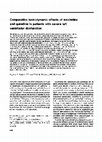Papers by Stephen Gottlieb

Critical Care Medicine, 2013
Acute kidney injury is a frequent complication of cardiac surgery and increases morbidity and mor... more Acute kidney injury is a frequent complication of cardiac surgery and increases morbidity and mortality. As preoperative biomarkers predicting the development of acute kidney injury are not available, we have tested the hypothesis that preoperative plasma levels of endogenous ouabain may function as this type of biomarker. Endogenous ouabain is an adrenal stress hormone associated with adverse cardiovascular outcomes. Its involvement in acute kidney injury is unknown. With studies in patients and animal settings, including isolated podocytes, we tested the above mentioned hypothesis. Preoperative endogenous ouabain was measured in 407 patients admitted for elective cardiac surgery and in a validation population of 219 other patients. We also studied the effect of prolonged elevations of circulating exogenous ouabain on renal parameters in rats and the influence of ouabain on podocyte proteins both "in vivo" and "in vitro." In the first group of patients, acute kidney injury (2.8%, 8.3%, 20.3%, p < 0.001) and ICU stay (1.4±0.38, 1.7±0.41, 2.4±0.59 days, p = 0.014) increased with each incremental preoperative endogenous ouabain tertile. In a linear regression analysis, the circulating endogenous ouabain value before surgery was the strongest predictor of acute kidney injury. In the validation cohort, acute kidney injury (0%, 5.9%, 8.2%, p < 0.0001) and ICU stay (1.2±0.09, 1.4±0.23, 2.2±0.77 days, p = 0.003) increased with the preoperative endogenous ouabain tertile. Values for preoperative endogenous ouabain significantly improved (area under curve: 0.85) risk prediction over the clinical score alone as measured by integrate discrimination improvement and net reclassification improvement. Finally, in the rat model, elevated circulating ouabain reduced creatinine clearance (-18%, p < 0.05), increased urinary protein excretion (+ 54%, p…
Journal of the American College of Cardiology, 2011
New England Journal of Medicine, Apr 1, 2005
Circulation. Heart failure, 2012

Respiration physiology, 1987
Previous studies have suggested that prostaglandin synthesis inhibition might alter lung water ac... more Previous studies have suggested that prostaglandin synthesis inhibition might alter lung water accumulation in low pressure pulmonary edema. Therefore we studied the effects of indomethacin administration on edema formation, hemodynamics, and gas exchange in canine acid aspiration. Fourteen pentobarbital anesthetized dogs received 1 ml/kg of 0.1 N HCl intratracheally and then 7 received indomethacin (5 mg/kg) and 7 served as time controls. Lung liquid was measured in vivo by a double indicator technique and at the end of the experiment by gravimetric determinations. Following HCl administration, venous admixture (Qva/Qt) increased in both groups. Over the succeeding 4 h Qva/Qt decreased after indomethacin administration by 4.1 +/- 14.2%, but increased in the control group by 10.9 +/- 11.5% (P less than 0.05). Cardiac index remained constant in the control group but decreased after indomethacin from 232 +/- 89 ml X kg-1 X min-1 to 167 +/- 75 ml X kg-1 X min-1. Lung liquid accumulatio...
Journal of Cardiac Failure, 2014
New England Journal of Medicine, 2007
Journal of Cardiac Failure, 1998
Journal of Cardiac Failure, 2005

Anesthesiology, 1987
In canine pulmonary capillary leak induced by intravenous oleic acid, reducing pulmonary wedge pr... more In canine pulmonary capillary leak induced by intravenous oleic acid, reducing pulmonary wedge pressure (Ppw) reduces pulmonary edema, venous admixture (Qva/Qt), and cardiac output (Qt). The authors tested the possibility that in another canine model of pulmonary capillary leak, that induced by endobronchial instillation of hydrochloric acid, nitroprusside would reduce Ppw and edema without reducing Qt or oxygen delivery (QO2). In 18 dogs, the authors measured extravascular lung water (EVLW) by thermal-dye dilution and the hemodynamic and gas exchange variables before and at intervals (1, 1.5, 3, and 5 h) after .1 N HCl bronchial infusion. By 1 h, HCl increased EVLW from 175 to 250 ml and Qva/Qt from 11 to 21%. Immediately after the 1-h measurements, the dogs were divided into three equal groups: six controls (C) were maintained with a Ppw of 12 mmHg, while plasmapheresis (P) or nitroprusside (NP) reduced Ppw to 5 mmHg for the next 4 h. EVLW continued to increase to 548 ml in C, but did not increase further in P and NP. Weights of lungs excised at 5 h confirmed that P and NP reduced edema by 50% in 4 h. In C, Qva/Qt increased, but there was no reduction in Qt or QO2. In contrast, plasmapheresis reduced Qva/Qt, Qt, and QO2. With nitroprusside, Qt and QO2 were maintained despite reduced Ppw at 1.5 and 3 h, and Qva/Qt did not decrease as in Group P. We conclude that plasmapheresis-induced reduction in Ppw reduces the pulmonary capillary leak and venous admixture following acid aspiration, but this has the potentially adverse effect of reducing cardiac output and oxygen delivery.(ABSTRACT TRUNCATED AT 250 WORDS)

The American Journal of Cardiology, 1991
Quinidine causes vasodilation directly and by inhibition of adrenergic vasoconstriction, but it a... more Quinidine causes vasodilation directly and by inhibition of adrenergic vasoconstriction, but it also exerts negative inotropic activity. Although this drug is often administered to patients with severe congestive heart failure, the net consequences of these opposing actions have not been evaluated in such patients. The hemodynamic and neurohormonal response to oral quinidine (600 mg) in 19 patients with severe chronic heart failure was therefore determined. Vasodilation was the predominant effect of quinidine, with reductions in mean arterial, left ventricular filling and right atriai pressures of -9% (confidence interval [Cl] -5 to -13), -8% (Cl -19 to 3), -15% (Cl -26 to -4), respectively. The quinidine-induced vasodilation increased plasma norepinephrine and epinehrine concentrations by 44% (Cl +17 to +72) and 47% (Cl +2 to +91), respectively. No change in cardiac performance was noted, with the cardiac index slightly increased (+lO%, CI +2 to +17) and stroke work index unchanged (O%, Cl -11 to +ll) after quinidine. Although the mean serum quinidine concentration was within the therapeutic range or lower in all patients, the serum quinidine concentration and the change in mean arterial pressure did correlate (r* = 0.64). In conclusion, vasodilation is the predominant hemodynamic effect of oral quinidine in patients with congestive heart failure. However, potential adverse effects may be caused by consequent neurohormonal activation. (Am1 Cardiol 1991;67:726-731)
American Heart Journal, 1989

American Heart Journal, 1991
Comparative hemodynamic effects of mexiletine and quinidine in patients with severe left ventricu... more Comparative hemodynamic effects of mexiletine and quinidine in patients with severe left ventricular dysfunction Mexilettne and quinidine are often administered to patients with severe congestive heart failure, but their hemodynamic effects have not been adequately studied In these individuals. In a randomized, crossover study, the hemodynamic responses to single oral doses of quinidlne (600 mg) and mexiletine (400 mg) were compared in 20 patlents with marked left ventricular dysfunction. Qulnidine predominantly caused vasodllation, with mean arterial, left ventricular filltng, and right atrial pressures all decreasing (-7 + 2, -2.3 + 1.0, and -1.1 + 0.5 mm Hg, respectively) and the systemic vascular resistance also declining (-306 ? 84 dynes . set . cm5). In contrast, the systemic vascular resistance increased (314 5 84 dynes . sec. cmm5) and the mean arterial, left ventricular filling, and rlght atrial pressures also increased (+2 rt 2, +6.1 + 1.8, and +1.8 + 0.6 mm Hg, respectively) after mexiletine. Cardiac performance declined with mexiletine (cardiac and stroke work indexes decreasing -0.3 + 0.1 L/min/m2 and -5 * 1 gm . m/m2, respectively), but there was no significant change in cardiac or stroke work indexes with quinidine (+O.l L/min/m2 and -0.3 rt 0.9 gm . m/m2, respectively).

American Heart Journal, 1994
Significant decreases in blood pressure (BP) may occur when administration of angiotensin-convert... more Significant decreases in blood pressure (BP) may occur when administration of angiotensin-converting enzyme (ACE) inhibitors is initiated for the treatment of heart failure. The purpose of this study was to compare the safety and tolerability of recommended initial doses of the longer-acting ACE inhibitor enalapril (ENAL) with those of the shorter-acting captopril (CAP) in patients with heart failure who were treated concomitantly with digitalis and diuretic agents. We evaluated BP, serum ACE activity, and clinical status when a low, first dose of ENAL (2.5 mg, n = 59) or CAP (6.25 mg, n = 58) was administered in a double-blind, randomized, and parallel fashion to 117 patients with mild to moderate heart failure. BP and serum ACE activity were measured at 30 min and hourly for 8 hours after drug administration. BP decreases were similar for both groups (mean supine BP -6.2/-4.8 mm Hg for ENAL vs -8.3/-6.4 mm Hg for CAP; mean standing BP -9.2/-5.6 mm Hg for ENAL vs -10.0/-4.7 mm Hg for CAP). Although the maximum mean decrease in BP occurred at hours 4 and 5 in the ENAL group and hours 1 and 2 in the CAP group, considerable between-group overlap was observed for individual patients. Decreases in mean serum ACE activity occurred earlier and were of shorter duration in the CAP group. ENAL significantly inhibited serum ACE activity to a greater extent than did CAP at all time points except the 1st hour. Administration of a first dose of ENAL, 2.5 mg or CAP, 6.25 mg to patients with heart failure was well tolerated.

Dis Manag Health Outcomes, 2006
ABSTRACT Heart failure management programmes are now widely accepted as a mechanism for improving... more ABSTRACT Heart failure management programmes are now widely accepted as a mechanism for improving quality of care. Although initial uncontrolled data suggested decreased costs with such programmes, more recent data suggest better outcomes may be the true result. The potential reasons are many, including education, an improved therapeutic relationship, or higher quality care provided by knowledgeable personnel (nursing or medical). These benefits could lead to increased compliance, better medications, or the early detection and treatment of problems. Data from the University of Maryland telemonitoring programme confirm that the close follow-up of patients led to improved quality of life. Scores on the Minnesota Living with Heart Failure questionnaire and the Short Form 36 mental composite and physical composite improved significantly over one year.Brain natriuretic peptide concentration and body weight also decreased significantly. These findings were made in closely followed groups with or without telemonitoring. Our study therefore supports the concept that close follow-up can improve both quality of life and physiological parameters, but the reasons are not clear. Studies that compare interventions are now needed.
Journal of Cardiac Failure, Jul 1, 2000
The beneficial effects of beta-adrenergic blockade on mortality rates in patients after a myocard... more The beneficial effects of beta-adrenergic blockade on mortality rates in patients after a myocardial infarction have been clear for decades. The efficacy data are now just as apparent for patients with heart failure. Although there are many subgroups of patients in whom the mortality effects of beta-blockers are not proven, knowledge about these specific populations continues to increase. Nevertheless, more information is needed so that we can properly tailor our therapy for individual patients.
Circulation, Mar 10, 2015











Uploads
Papers by Stephen Gottlieb